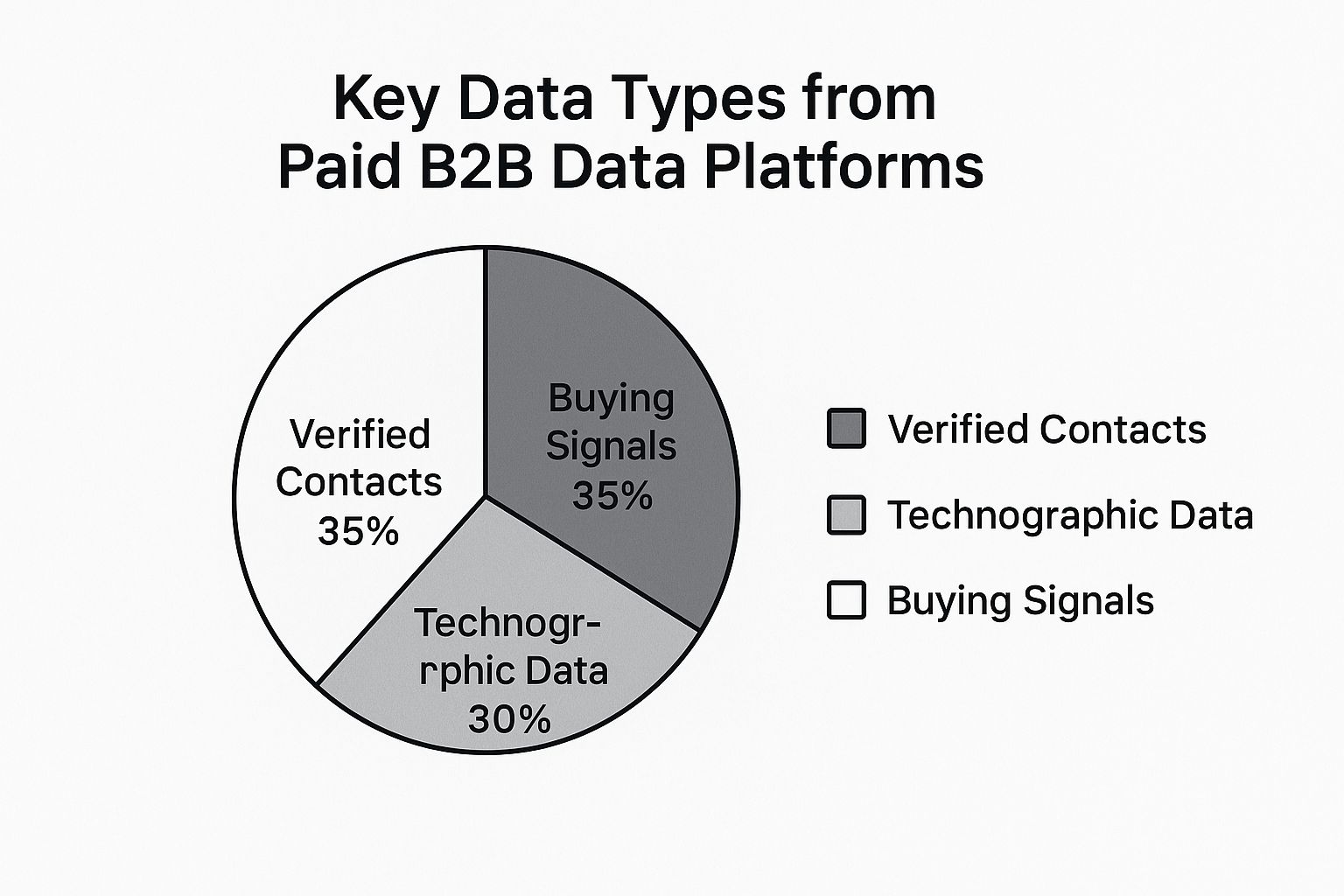Finding company information isn't just about a quick Google search anymore. To really succeed in B2B sales, you have to dig deeper, piecing together clues from public records, social networks, and specialized databases. The aim is to build a full picture—their financial stability, who they just hired, and even the software they're running.
Why Smart Company Research Wins Deals

Let's be real: basic contact info just doesn't cut it. The true secret to landing big B2B deals is getting past the surface-level stuff. It's about uncovering the details that can turn a generic cold pitch into a conversation they actually want to have.
This is where doing your homework really pays off.
The Real Goal of Company Research
Stop thinking about it as just collecting names and numbers. Your real job is to be a detective, building a complete profile of your target. You're looking for clues that point to their current challenges and future plans.
I always focus my investigation on a few key areas:
- Recent Funding Rounds: A fresh pile of cash is a massive buying signal. It almost always means they're expanding, kicking off new projects, and have a budget to spend.
- Key Executive Hires: When a company brings in a new VP of Sales or a new CMO, one of the first things they do is review their team's tools and processes. This is your window of opportunity.
- Technology Stack: Knowing what software they already use is invaluable. You can position your product as the perfect integration or a much-needed upgrade to what they're already using.
This whole process—gathering data and turning it into real, actionable insights—is the heart of what we call sales intelligence. It’s not just about what you know, but how you use that knowledge to make a genuine connection.
Getting a handle on what is sales intelligence will completely change your outreach game from spammy to strategic. This guide will show you how to find the right data, the kind that helps you spot real opportunities and, ultimately, close more deals.
Start with Publicly Available Intelligence

Before you even think about paid tools or complex databases, your first move should always be to check out what a company is telling the world about itself. The best intel is often hiding in plain sight, and a company's own digital footprint is a fantastic place to start digging.
It sounds obvious, but you'd be surprised how much you can learn by going beyond the homepage. The real goal is to get a feel for their story—what are their big goals, what problems are they trying to solve, and what's happening right now inside their walls? A deep dive into their website can reveal a ton about their internal world.
Dissecting a Company's Website
Your first click should be the 'About Us' page. Don't just skim it. This page tells you the story they want people to hear, packed with their mission and core values. Ask yourself: does this mission resonate with what my product helps companies achieve? It's a quick and easy way to see if there's a potential fit from the get-go.
Next, I always jump over to their 'Careers' or 'Jobs' section. This is my secret weapon. Open roles are a direct signal of a company's priorities and, more importantly, their pain points.
- Hiring a bunch of new sales reps? That’s a clear sign they’re pushing hard for growth.
- Searching for a new Head of Engineering? They might be gearing up for a major product pivot or rebuilding their tech stack.
- Recruiting more customer support agents? This could mean they're having trouble keeping up with new customers or facing retention issues.
Finally, check out their 'News' or 'Press' page. This is basically a timeline of their recent wins. Look for press releases on new product launches, funding rounds, or big-name partnerships. These are the perfect triggers for a timely, well-informed outreach.
Never underestimate what these public pages can tell you. Companies spend a lot of time and money crafting these messages, giving you a clear window into their current focus and needs.
Mastering Smart Search Tactics
After you've scoured their website, it’s time to see what the rest of the internet is saying. With Google dominating over 90% of the search market, it's the natural next step. It's also worth noting that 46% of all searches have local intent, a stat that can be a game-changer depending on your territory. You can get more context on these trends in this Google Business Profile statistics breakdown.
Get creative with your search terms to find information they might not feature on their own site. For example, a simple query can uncover a wealth of information about a company's financial health and strategic direction.
Searching something like "[Company Name] funding round" can instantly pull up articles detailing how much they raised, which VC firms invested, and exactly how they plan to spend that new cash. That's pure gold for a sales professional.
Tap Into Professional and Social Networks
Company data on its own is just… flat. It’s a list of facts and figures. The real story, the part that actually helps you sell, comes from the people who work there. That’s where professional networks, especially LinkedIn, become an absolute goldmine. But you have to know how to dig deeper than the company’s main page.
Think of the employee list on LinkedIn as a live, interactive org chart. In just a few minutes, you can get a surprisingly clear picture of their team structure and figure out who reports to whom. It’s one of the best ways I know to find the decision-makers you actually need to talk to—the ones whose names aren't on the corporate "About Us" page.
Let's say you sell marketing automation software. Just filter a target company’s employee list by the term "marketing." Suddenly, you see the entire department laid out: the VP, the directors, the managers, right down to the specialists. This isn't just a list of names; it’s a map of influence.
Reading Between the Lines
Here’s where it gets really interesting. The magic happens when you start paying attention to what the people at your target accounts are doing and saying online. Their activity is full of unintentional buying signals that tell you the perfect time to reach out.
This is critical because your prospects are already doing their own research. A staggering 66% of B2B buyers in the U.S. are looking for solutions online long before they ever agree to a call with a salesperson. You can find more details on this shift in B2B buyer behavior on greenapplestrategy.com. They're forming opinions without you.
You have to learn to spot the signals. They’re often subtle, but they’re there if you look.
- A new executive hire: See a company just brought on a new VP of Sales? That's a classic trigger event. New leaders almost always have the budget and the motivation to shake things up and review their current tools.
- Rapid team growth: Is a company suddenly hiring a dozen new software engineers? That’s a massive clue they’re about to kick off a major product push or expansion.
- What employees are posting: Keep an eye on individual posts. When a sales manager starts publicly complaining about the limitations of their CRM, that's not just a post—it's an open invitation for a conversation.
When you monitor these networks, you're doing more than just collecting names. You're gathering context. And that human context is what lets you ditch the generic pitch and craft a message that speaks directly to what a prospect needs, right now.
Unlock Deeper Insights with B2B Data Platforms
You've squeezed every last drop of intel out of company websites and LinkedIn profiles. What's next? This is the point where you need to go beyond the publicly available clues and start digging into proprietary intelligence. B2B data platforms are built for this exact purpose—to uncover the kind of company information you can't just find with a Google search.
These tools are your ticket to bypassing gatekeepers. They don't just give you a generic office line; they provide verified direct-dial numbers, accurate email addresses, and even detailed org charts. Suddenly, you're not just another cold caller; you're connecting directly with the right decision-makers.
Going Beyond Contacts: Technographics and Buying Signals
One of the real game-changers with these platforms is getting access to technographic data. Think about it: what if you knew a prospect's entire software stack before you even picked up the phone? You could see they're using a direct competitor, a tool that integrates perfectly with yours, or an ancient system practically begging for an upgrade. That's how you craft a pitch that actually resonates.
On top of that, the best platforms serve up real-time buying signals. These are triggers that tell you a company is actively looking for a solution like yours right now. For example, you might get an alert that a target account just posted a job for a "VP of Sales Operations" or that their website traffic shows a spike in searches for keywords related to your product.
This isn't just data; it's a roadmap to your prospect's immediate needs. You're no longer guessing who might be a good fit. Instead, you're acting on hard evidence that shows they're in-market and ready to talk.
The chart below breaks down the most valuable types of data you get from these paid platforms.

As you can see, the value isn't just in one area. It's an almost even split between finding the right people, understanding the tools they already use, and knowing the perfect time to reach out.
This is a powerful combination for scaling up your prospecting. If you're ready to invest in building a more predictable pipeline, your next step should be to explore the different company information databases available.
Master Advanced Search to Find Hidden Gems

Knowing where to look for company information is just the start. The real skill is knowing how to search. This is what separates the amateur from the expert—using simple tools to unearth details that most people completely miss.
With just a few clever tricks, you can turn a regular search engine into a serious prospecting tool. The secret is mastering search operators, which are basically little commands you add to your search terms to get hyper-specific results.
Go Beyond Basic Keywords
Think beyond just typing a company's name into the search bar. You can actually tell the search engine exactly where to look and what kind of file to look for. This is a game-changer when you're trying to find that one specific document buried in a mountain of content.
Let's say you're trying to find a tech company's annual report to get a feel for their financial priorities. A simple search will likely flood you with news articles and blog posts. A smarter query, however, cuts right through the noise.
- Try this:
site:targetcompany.com filetype:pdf "annual report 2023"
This command tells the search engine to only show you PDF files from that specific company's website containing the exact phrase "annual report 2023." Simple, right?
This isn't just a party trick; it's a massive shortcut. It helps you instantly locate official documents, case studies, or whitepapers that spell out a prospect's challenges and goals. It’s an incredibly effective technique when you need to find private company financial information.
Uncover Pain Points and Priorities
You can also structure your searches to find conversations that reveal a company's real-world problems. People talk online, and those discussions are a goldmine for anyone who knows how to listen in.
Imagine you sell cybersecurity software. You could search for something like this: inurl:forum "Target Company" + "data breach concerns"
This search specifically looks for the phrase "data breach concerns" in online forums where your target company is being discussed. You get a direct line into their publicly known issues, which makes your outreach incredibly timely and relevant.
This level of detail is more important than ever. The average Google query is now 3.4 words long, and a full 15% of daily searches are brand new, never-before-seen queries. You can dig into more of these modern search behaviors from semrush.com. Getting specific helps you stand out.
Turning Information Into Opportunity
So, you’ve done your homework. You've dug through websites, scoured LinkedIn profiles, and maybe even found a few juicy industry reports. But raw data on its own won't close any deals. The real magic happens when you weave all those threads together into a cohesive story that leads directly to a smart outreach. This is how you move from just knowing about a company to truly understanding their needs.
Let’s walk through a real-world example. Say you sell project management software. You see a press release that one of your target companies just landed a $20 million Series B funding round.
Connecting the Dots
That funding announcement is more than just a piece of news; it’s your starting gun. It's a clear signal that big things are about to happen, and you need to figure out how to be a part of it.
Here’s how you can start connecting the dots:
-
First, hit their careers page. What do you see? They’re hiring five new software developers and a product manager. That tells you they're putting that new capital to work immediately to scale their product team. More people means more complexity.
-
Next, head over to LinkedIn. You discover the new VP of Engineering just came on board two months ago. A quick look at her profile shows her last company was a customer of your main competitor. Interesting.
-
Finally, scroll through social media. You find a post from one of their current engineers complaining (subtly, of course) about how clunky their internal development tools are. That’s gold.
You see how this works? You’ve gone from a single data point to a complete picture. The funding is the opportunity, the new hires signal an urgent need for better organization, and that engineer's post reveals the specific pain point.
Now you’re ready to reach out. Instead of a generic "Hey, saw you got funded, wanna see a demo?" email, you can craft something powerful. You can send a message to that new VP, congratulate her on the new role and the funding, and mention you understand the chaos that comes with scaling an engineering team. You can then subtly reference how your platform helps solve the exact frustrations her team is already talking about online.
That’s how you turn solid research into actual revenue.
Got Questions? We've Got Answers
You're not alone. When it comes to digging up company info for prospecting, a few questions pop up time and time again. Let's get them sorted so you can focus your research on what actually moves the needle.
The real skill in research isn't just knowing what to look for, but where to find it. There's no single magic database with all the answers. The trick is knowing which tool to pull out of your toolkit for the specific piece of information you need.
Where Can I Find Reliable Financial Data?
This really depends on whether the company is public or private.
For any publicly traded company, your best bet is to go straight to the source: their investor relations website. This is where you'll find their official SEC filings. The 10-K annual report is the gold standard—it’s packed with audited financial data, strategic insights, and a clear picture of their performance.
Private companies are a tougher nut to crack because they aren't obligated to share financials. For these, you'll need to turn to a paid data platform. Services like Crunchbase, PitchBook, or Dun & Bradstreet are your best options. They use their own data models to provide solid estimates on funding, revenue, and overall financial health.
How Do I Find a Decision-Maker's Direct Email?
This is a classic two-step process. First, find your target on LinkedIn. This confirms their current title and that they are, in fact, still at the company.
Once you have a name and title, you can use an email finder tool like Hunter or Snov.io. These tools scan the company's domain and predict the most likely email format, such as first.last@company.com.
My Two Cents: Don't skip the verification step. Before you send anything, run the email you found through a validation tool. This small check saves your sender reputation by cutting down on bounced emails and making sure your message actually gets delivered.
What's the Best Way to Keep Up With Company News?
Timing is everything in sales. To stay on top of a company's latest moves, set up a Google Alert for their name. It's free, easy, and will send any new press releases or news mentions straight to your inbox.
Beyond that, make it a habit to follow their official company page on LinkedIn. This one-two punch ensures you see both the big announcements from news outlets and the smaller, day-to-day updates that often make for the best conversation starters.
